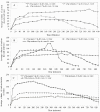Molasses as a source of carbon dioxide for attracting the malaria mosquitoes Anopheles gambiae and Anopheles funestus
- PMID: 24767543
- PMCID: PMC4020376
- DOI: 10.1186/1475-2875-13-160
Molasses as a source of carbon dioxide for attracting the malaria mosquitoes Anopheles gambiae and Anopheles funestus
Abstract
Background: Most odour baits for haematophagous arthropods contain carbon dioxide (CO2). The CO2 is sourced artificially from the fermentation of refined sugar (sucrose), dry ice, pressurized gas cylinders or propane. These sources of CO2 are neither cost-effective nor sustainable for use in remote areas of sub-Saharan Africa. In this study, molasses was evaluated as a potential substrate for producing CO2 used as bait for malaria mosquitoes.
Methods: The attraction of laboratory-reared and wild Anopheles gambiae complex mosquitoes to CO2 generated from yeast-fermentation of molasses was assessed under semi-field and field conditions in western Kenya. In the field, responses of wild Anopheles funestus were also assessed. Attraction of the mosquitoes to a synthetic mosquito attractant, Mbita blend (comprising ammonia, L-lactic acid, tetradecanoic acid and 3-methyl-1-butanol) when augmented with CO2 generated from yeast fermentation of either molasses or sucrose was also investigated.
Results: In semi-field, the release rate of CO2 and proportion of An. gambiae mosquitoes attracted increased in tandem with an increase in the quantity of yeast-fermented molasses up to an optimal ratio of molasses and dry yeast. More An. gambiae mosquitoes were attracted to a combination of the Mbita blend plus CO2 produced from fermenting molasses than the Mbita blend plus CO2 from yeast-fermented sucrose. In the field, significantly more female An. gambiae sensu lato mosquitoes were attracted to the Mbita blend augmented with CO2 produced by fermenting 500 g of molasses compared to 250 g of sucrose or 250 g of molasses. Similarly, significantly more An. funestus, Culex and other anopheline mosquito species were attracted to the Mbita blend augmented with CO2 produced from fermenting molasses than the Mbita blend with CO2 produced from sucrose. Augmenting the Mbita blend with CO2 produced from molasses was associated with high catches of blood-fed An. gambiae s.l. and An. funestus mosquitoes.
Conclusion: Molasses is a suitable ingredient for the replacement of sucrose as a substrate for the production of CO2 for sampling of African malaria vectors and other mosquito species. The finding of blood-fed malaria vectors in traps baited with the Mbita blend and CO2 derived from molasses provides a unique opportunity for the study of host-vector interactions.
Figures





Similar articles
-
2-Butanone as a carbon dioxide mimic in attractant blends for the Afrotropical malaria mosquitoes Anopheles gambiae and Anopheles funestus.Malar J. 2017 Aug 24;16(1):351. doi: 10.1186/s12936-017-1998-2. Malar J. 2017. PMID: 28836977 Free PMC article.
-
Enhancing Attraction of African Malaria Vectors to a Synthetic Odor Blend.J Chem Ecol. 2016 Jun;42(6):508-16. doi: 10.1007/s10886-016-0711-1. Epub 2016 Jun 27. J Chem Ecol. 2016. PMID: 27349651
-
Sugar-fermenting yeast as an organic source of carbon dioxide to attract the malaria mosquito Anopheles gambiae.Malar J. 2010 Oct 25;9:292. doi: 10.1186/1475-2875-9-292. Malar J. 2010. PMID: 20973963 Free PMC article.
-
Function and composition of male accessory gland secretions in Anopheles gambiae: a comparison with other insect vectors of infectious diseases.Pathog Glob Health. 2012 May;106(2):82-93. doi: 10.1179/2047773212Y.0000000016. Pathog Glob Health. 2012. PMID: 22943543 Free PMC article. Review.
-
Stereoscopic video analysis of Anopheles gambiae behavior in the field: challenges and opportunities.Acta Trop. 2014 Apr;132 Suppl(0):S80-5. doi: 10.1016/j.actatropica.2013.06.021. Epub 2013 Jul 10. Acta Trop. 2014. PMID: 23850507 Free PMC article. Review.
Cited by
-
Mass mosquito trapping for malaria control in western Kenya: study protocol for a stepped wedge cluster-randomised trial.Trials. 2016 Jul 26;17:356. doi: 10.1186/s13063-016-1469-z. Trials. 2016. PMID: 27460054 Free PMC article. Clinical Trial.
-
Field evaluation of a novel synthetic odour blend and of the synergistic role of carbon dioxide for sampling host-seeking Aedes albopictus adults in Rome, Italy.Parasit Vectors. 2014 Dec 11;7:580. doi: 10.1186/s13071-014-0580-9. Parasit Vectors. 2014. PMID: 25499569 Free PMC article.
-
Reception of odors and repellents in mosquitoes.Curr Opin Neurobiol. 2015 Oct;34:158-64. doi: 10.1016/j.conb.2015.06.014. Epub 2015 Jul 17. Curr Opin Neurobiol. 2015. PMID: 26202080 Free PMC article. Review.
-
Attraction of mosquitoes to primate odours and implications for zoonotic Plasmodium transmission.Med Vet Entomol. 2020 Mar;34(1):17-26. doi: 10.1111/mve.12402. Epub 2019 Aug 17. Med Vet Entomol. 2020. PMID: 31420992 Free PMC article.
-
Detection of West Nile virus in a common whitethroat (Curruca communis) and Culex mosquitoes in the Netherlands, 2020.Euro Surveill. 2020 Oct;25(40):2001704. doi: 10.2807/1560-7917.ES.2020.25.40.2001704. Euro Surveill. 2020. PMID: 33034280 Free PMC article.
References
-
- Takken W. The role of olfaction in host-seeking of mosquitoes: a review. J Trop Insect Sci. 1991;12:287–295. doi: 10.1017/S1742758400020816. - DOI
-
- Gillies MT. The role of carbon dioxide in host-finding by mosquitoes (Diptera: Culicidae): a review. Bull Entomol Res. 1980;70:525–532. doi: 10.1017/S0007485300007811. - DOI
Publication types
MeSH terms
Substances
LinkOut - more resources
Full Text Sources
Other Literature Sources

